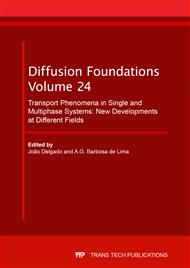[1]
S.N. Dasgupta, F. Aminzadeh, Geophysics for petroleum engineers (in Portuguese). Translation Furmankiewicz, Edson. Elsevier Ed. Ltda, 1º Edição, Rio de Janeiro, 304 p, (2015).
Google Scholar
[2]
D.A. Nield, Modelling fluid flow in saturated porous media and at interfaces, (2000) 1-19.
Google Scholar
[3]
L.P. Dake, Fundamentals of reservoir engineering, Elsevier Science B. V., Amsterdam, 437 p, (1998).
Google Scholar
[4]
L.W. Lake, J. Russel, B. Rossen, G. Pope, Fundamentals of Enhanced Oil Recovery, Society of Petroleum Engineers, New York, 496 p, (2014).
Google Scholar
[5]
B.C. Craft, M.F. Hawkins, Applied petroleum reservoir engineering, Pearson Education, Massachusetts, USA, 493 p, (2015).
Google Scholar
[6]
V. Martinez, F. Ascencio, A new practical water injection system in offshore fields, in Offshore Technology Conference, Houston, (2018) 1-9.
DOI: 10.4043/28741-ms
Google Scholar
[7]
W.C. Lyons, Working guide to reservoir engineering, Elsevier Science, Oxford, 316 p, (2010).
Google Scholar
[8]
Q. Lei, W. Xiong, J. Yuan, S. Gao, Y. Wu, Behavior of flow through low-permeability reservoirs, Annual Conference and Exhibition, Society of Petroleum Engineers, Rome, (2008) 1-7.
Google Scholar
[9]
K. Aziz, A. Settari, Petroleum reservoir simulation, Applied Science Publishers Ltd, London, 476 p, (1979).
Google Scholar
[10]
D.W. Peaceman, Fundamentals of numerical reservoir simulation, Elsevier Scientific Publishing Company, Developments in Petroleum Science, Amsterdam, 176 p, (1977).
Google Scholar
[11]
F.A. Batista, Multiphase flow in porous media via generalized coordinates. Casy Study: petroleum reservoir Doctoral Thesis, Federal University of Campina Grande, 174p, 2011. (In Portuguese).
Google Scholar
[12]
Z. Chen, G. Huan, Y. Ma, Computational methods for multiphase flows in porous media, Society for Industrial and Applied Mathematics, Dallas, 549 p, (2006).
Google Scholar
[13]
B.G. Coutinho, Numerical solution of oil reservoir problems using generalized coordinates (in Portuguese), Master thesis, Federal University of Campina Grande, Campina Grande, 180 p, (2002).
DOI: 10.21475/ajcs.18.12.02.pne612
Google Scholar
[14]
F.A. Batista, B.G. Coutinho, S.R. Farias Neto, A.G.B. Lima, Two-phase Flow (Oil-Water) in Petroleum Reservoir with Irregular Geometry Including Water Injection: Effect of Porosity on the Oil Recovery Factor, Defect and Diffusion Forum, (2012) 181-186.
DOI: 10.4028/www.scientific.net/ddf.326-328.181
Google Scholar
[15]
B.R.C. Correia, Simulation of oil reservoirs with complex geometry via the finite volume method and generalized coordinates. Master thesis, Federal University of Campina Grande, Campina Grande, 156 p, 2016. (In Portuguese).
DOI: 10.21475/ajcs.18.12.02.pne612
Google Scholar
[16]
F. Marcondes, Numerical solution using adaptive-implicit methods and Voronoi mesh of oil reservoir problems. Doctoral Thesis, Federal University of Santa Catarina, Florianópolis, Brazil, 138 p, 1996. (In Portuguese).
Google Scholar
[17]
F.F. Craig JR., The reservoir engineering aspects of waterflooding, SPE Monograph Series, Society of Petroleum Engineers of AIME, New York, 134 p, (1971).
Google Scholar


